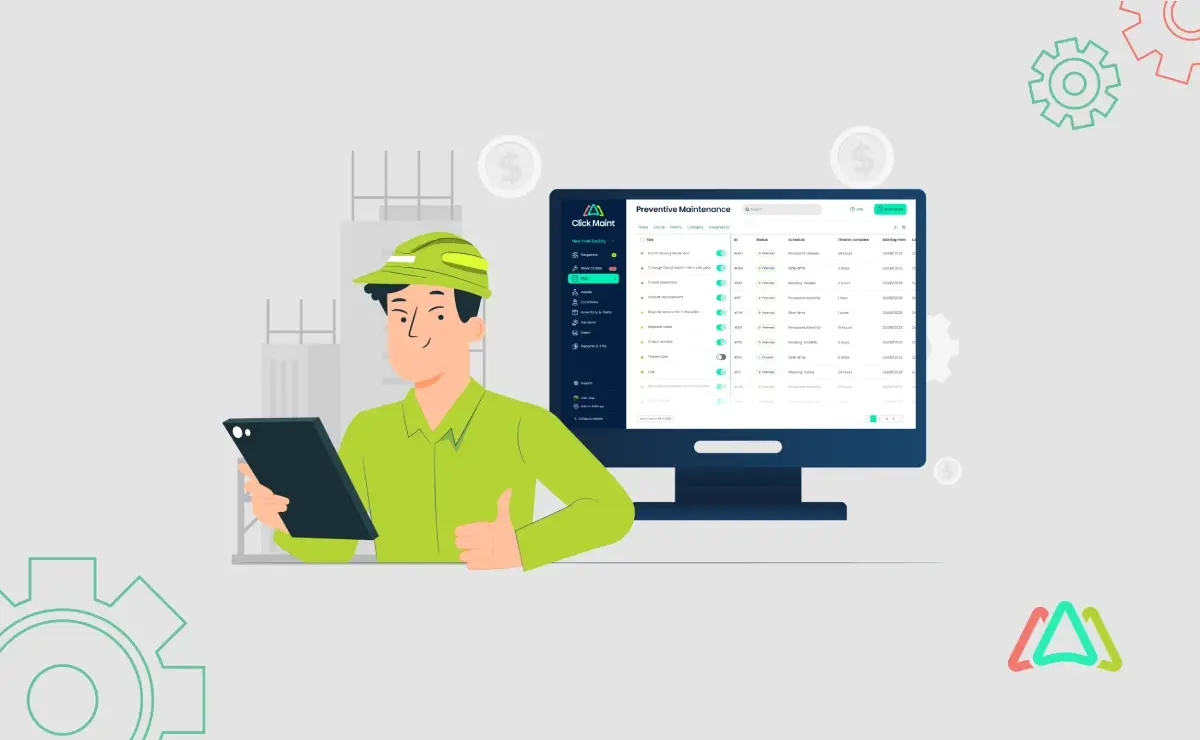
Tips for Maintenance Managers of Small Businesses Evaluating CMMS Software
Effective maintenance management is important for the sustained operation and profitability of any small business. By ensuring equipment and assets are properly maintained, small businesses can significantly reduce downtime and operational costs. Efficient maintenance practices not only enhance productivity but also extend the lifespan of critical assets, thus avoiding costly replacements or repairs. A computerized maintenance management software (CMMS) is essential to accomplishing efficient maintenance operations. CMMS software automates and organizes maintenance tasks, from work order generation to scheduling preventive maintenance, thereby improving overall efficiency. By digitizing maintenance workflows, CMMS enables businesses to track asset performance, manage inventory, and enhance regulatory compliance seamlessly.
The purpose of this article is to guide maintenance managers of small businesses in evaluating CMMS software effectively. You will get insights into essential features to look for in CMMS solutions tailored for small business needs, understand cost considerations, usability factors, and the strategic advantages of preventive maintenance. By the end, you will be equipped with the knowledge to make informed decisions in selecting and implementing the right CMMS software to optimize their maintenance processes and business operations.
Importance Of CMMS Software To Small Business
CMMS offers numerous benefits for small businesses. Maintenance management software adoption empowers small businesses to manage their maintenance operations more effectively, leading to improved productivity, reduced operational costs, and enhanced regulatory adherence, ultimately contributing to the organization's overall success and sustainability. Also, it improves operational efficiency by automating routine tasks like work order creation and scheduling, thereby reducing manual errors and delays, and helps in cost reduction by optimizing maintenance schedules, minimizing equipment downtime, and prolonging asset lifespan through proactive maintenance practices. Finally, CMMS enhances regulatory compliance by ensuring that maintenance activities adhere to industry standards and regulations, thereby mitigating risks associated with non-compliance.
Key Features to Look for in CMMS Software for Small Businesses
When evaluating CMMS software for small businesses, several essential features can significantly impact operational efficiency and cost-effectiveness.
Cost-effectiveness
This is paramount, balancing initial investment against long-term savings. CMMS systems that offer scalable pricing models, such as subscriptions or one-time purchases, provide flexibility based on budget and operational needs. It's important to consider hidden costs like training, ongoing support, and system upgrades, as these can impact the total cost of ownership over time.
Subscription models often include regular updates and support, reducing upfront costs but potentially adding up over the subscription period. In contrast, one-time purchases may require larger initial investments but can be more cost-effective in the long run for businesses with stable maintenance needs.
By carefully analyzing these factors, small businesses can choose a CMMS solution that aligns with their budget constraints and operational goals, ensuring efficient maintenance management by moving from spreadsheets to CMMS without the financial burden. These considerations empower businesses to maximize the benefits of CMMS, optimizing maintenance workflows and enhancing overall business performance.

Ease of Use
A user-friendly CMMS software is vital in promoting an intuitive design that simplifies navigation and task execution for maintenance teams. Accessible training and robust vendor support are essential for users to learn and troubleshoot the system effectively. A smooth onboarding process ensures rapid integration into daily operations, minimizing downtime and maximizing productivity. Considering user feedback and reviews offers valuable insights into real-world usability, helping your business choose a CMMS solution that maximizes operational efficiency and user satisfaction.
Simple Work Order Management
Efficient work order management in CMMS involves streamlined processes for creating, assigning, and managing work orders. The system tracks progress and completion, providing real-time updates and comprehensive reports on work order status. Customizable templates facilitate the quick creation of work orders tailored to specific maintenance tasks. Notifications and alerts keep users informed about updates, deadlines, and task assignments, ensuring timely action and minimal disruptions to operations. These features collectively enhance organizational efficiency and transparency, empowering small businesses to optimize maintenance workflows and maintain peak operational performance.

Preventive Maintenance
Preventive maintenance in CMMS involves scheduling regular tasks to manage equipment and assets proactively. Automating reminders ensures timely upkeep, minimizing the risk of unexpected breakdowns. Tracking maintenance history allows for informed decision-making based on past performance data. Compared to reactive maintenance, preventive strategies reduce downtime, extend asset lifespan, and lower overall maintenance costs by addressing issues before they escalate. By prioritizing proactive maintenance practices, small businesses can enhance operational reliability, improve efficiency, and ultimately optimize their maintenance management processes for sustained success.
Inventory and asset tracking
Inventory and asset tracking is important for small businesses to optimize efficiency and reduce operational costs. Effective asset management ensures equipment is maintained properly, minimizing downtime and extending lifespan. Technologies like barcode scanning and RFID enhance accuracy and speed in asset tracking, improving inventory control. Real-time inventory tracking keeps data current, enabling proactive decision-making to prevent stockouts or overstocking. Integration with procurement systems streamlines purchasing processes, synchronizing asset management with inventory needs for seamless operations. These features collectively empower small businesses to enhance productivity, reduce expenses, and maintain a competitive edge through efficient asset and inventory management practices.
Mobile App Accessibility
Mobile app accessibility is necessary for small business maintenance teams, offering flexibility and efficiency in managing tasks remotely. Benefits include real-time updates on work orders, asset status, and maintenance schedules, enhancing responsiveness and reducing downtime. Some of the essential CMMS mobile features include intuitive navigation, task assignment capabilities, and integrated notifications for timely alerts. Offline functionality ensures uninterrupted access to critical data even without internet connectivity, ensuring continuity in remote or field operations. A seamless user experience and interface design further enhance usability, allowing maintenance teams to maximize productivity and effectiveness while on the move.

Distinguishing from Enterprise Features
When evaluating CMMS software for small businesses, it's important to distinguish essential features from enterprise-level functionalities that may not be necessary. ERP integrations, for instance, involve linking CMMS with broader enterprise resource planning systems to synchronize data across departments. While beneficial for large organizations managing complex operations, small businesses may find these integrations overly complex and unnecessary for their streamlined needs.
Single Sign-On (SSO) simplifies user access by allowing one set of login credentials for multiple systems. While advantageous for large teams, small businesses with fewer users may find traditional login methods sufficient, avoiding the complexity and cost associated with SSO implementation.
Multi-site management capabilities cater to enterprises with operations across multiple locations, facilitating centralized control and data management. Small businesses operating from a single site may not require this feature, prioritizing simpler and more cost-effective maintenance management solutions tailored to their scale.
Similarly, multi-language support, beneficial for global enterprises, may hold less relevance for small businesses operating within localized markets. The cost and complexity of implementing and maintaining these features could outweigh the benefits for smaller operations focused on efficient maintenance management.
Ultimately, small businesses should prioritize CMMS features that directly enhance operational efficiency, such as cost-effectiveness, ease of use, and essential maintenance functionalities, ensuring optimal resource allocation and sustainable growth.

Selecting the Right CMMS for Your Business
Selecting the right CMMS software for your business involves careful consideration of several key factors to ensure it aligns with your operational needs and growth objectives. Evaluating vendor credibility and support is essential; researching vendor reputation, customer reviews, and responsiveness to support requests helps gauge reliability and service quality. Free trials and demos play a vital role in the selection process, allowing hands-on exploration of the software's features and usability before committing. This firsthand experience helps assess how well the CMMS meets specific requirements and integrates into existing workflows.
Customization and scalability are vital considerations, particularly for small businesses anticipating growth. The software should offer flexibility to adapt to evolving needs and scale alongside business expansion without significant disruptions or additional costs. Making the final decision involves weighing factors such as cost-effectiveness, ease of implementation, user feedback, and alignment with long-term business goals. It's essential to prioritize functionalities that streamline maintenance processes, enhance productivity, and deliver measurable ROI.
By methodically evaluating these criteria, small businesses can confidently select a CMMS solution that not only addresses current maintenance management challenges but also supports future growth and operational and maintenance excellence.
Conclusion
Adopting CMMS software tailored for small businesses offers many advantages in streamlining maintenance operations and enhancing overall efficiency. Throughout this article, we've highlighted key features essential for evaluating CMMS solutions, including cost-effectiveness, ease of use, and robust functionalities like work order management, preventive maintenance scheduling, and asset tracking.
Key takeaways include the importance of selecting a user-friendly system that supports seamless integration into existing workflows, provides adequate training and support and reduces maintenance related costs. Emphasizing preventive maintenance strategies can help reduce downtime and extend equipment lifespan, while mobile app accessibility ensures flexibility for on-the-go maintenance teams. We recommend small businesses prioritize vendor credibility, explore free trials, and consider customization and scalability to ensure long-term suitability. Investing in a CMMS not only improves operational reliability but also contributes to cost savings and regulatory compliance.
TABLE OF CONTENTS
Keep Reading
Last month, news outlets and the entire internet was abuzz with the return of NASA astronauts ...
3 Apr 2025
What comes first - CMMS or predictive maintenance? If your answer is either, it is correct. ...
28 Mar 2025
Artificial intelligence (AI) talk has become commonplace. Today, engaging in business-focused ...
27 Mar 2025
Imagine a world where machines predict, diagnose, and fix their issues before they fail. This ...
25 Mar 2025
A facility maintenance plan is at the core of a facility’s operations. This organized ...
21 Mar 2025
Think of managing your maintenance operations like managing a championship sports team. Just ...
21 Mar 2025
The maintenance sector is battling a severe talent shortage that threatens to undermine ...
7 Mar 2025
Manufacturing maintenance is the backbone of industrial efficiency, ensuring machines run ...
5 Mar 2025
No one likes playing a guessing game when equipment breaks down. Yet, maintenance teams often ...
4 Mar 2025
The size of the preventive maintenance software market is discussed in millions of dollars, ...
4 Mar 2025
The organizational structure and corporate hierarchy vary from company to company. Large ...
28 Feb 2025
Maintenance procedures are essential for ensuring the longevity and reliability of machinery ...
21 Feb 2025
Sustainability is no longer just a buzzword; it's a critical component of corporate social ...
20 Feb 2025
A Computerized Maintenance Management System (CMMS) relies on accurate, well-organized data ...
18 Feb 2025
In an era where technology drives operational efficiency, Computerized Maintenance Management ...
14 Feb 2025
A Computerized Maintenance Management System (CMMS) is a key component of modern maintenance ...
13 Feb 2025
Introduction Maintenance management is the foundation of maintenance operations in industries ...
11 Feb 2025
Introduction A Computerized Maintenance Management System (CMMS) is software designed to help ...
7 Feb 2025
Introduction Due to a growing awareness of the need to combat climate change, the green ...
6 Feb 2025
When your organization decides to invest in a CMMS (Computerized Maintenance Management ...
4 Feb 2025





